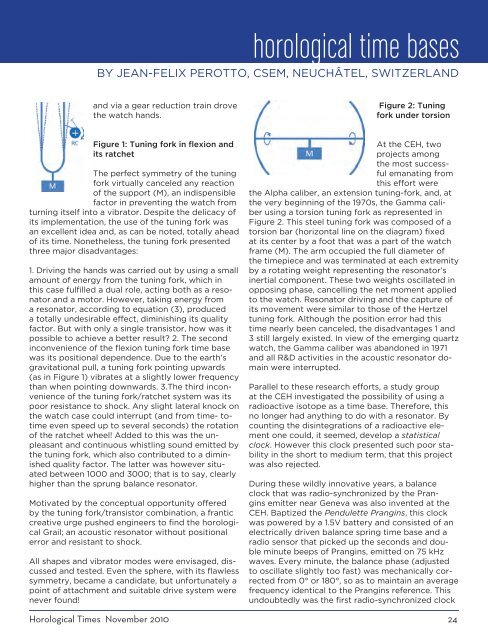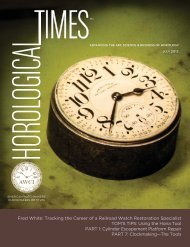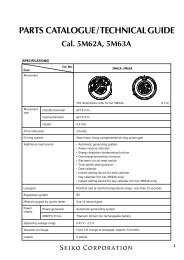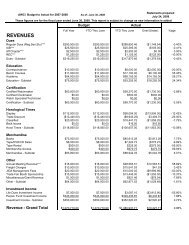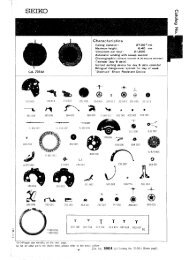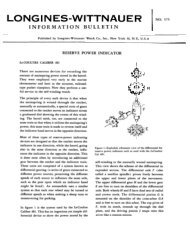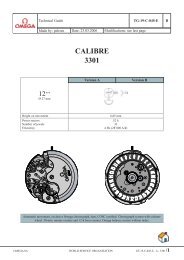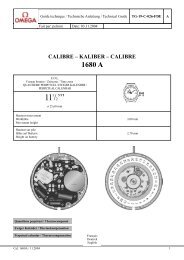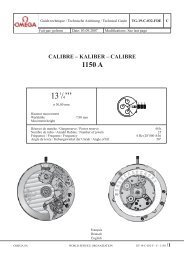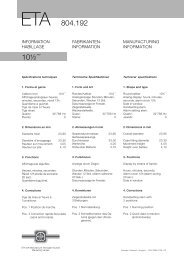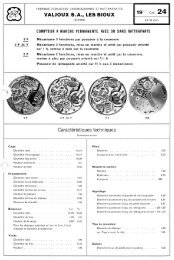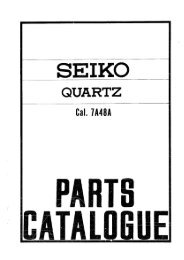PDF Version - The American Watchmakers-Clockmakers Institute
PDF Version - The American Watchmakers-Clockmakers Institute
PDF Version - The American Watchmakers-Clockmakers Institute
You also want an ePaper? Increase the reach of your titles
YUMPU automatically turns print PDFs into web optimized ePapers that Google loves.
horological time bases<br />
by Jean-Felix Perotto, CSEM, Neuchâtel, Switzerland<br />
and via a gear reduction train drove<br />
the watch hands.<br />
Figure 2: Tuning<br />
fork under torsion<br />
Figure 1: Tuning fork in flexion and<br />
its ratchet<br />
<strong>The</strong> perfect symmetry of the tuning<br />
fork virtually canceled any reaction<br />
of the support (M), an indispensible<br />
factor in preventing the watch from<br />
turning itself into a vibrator. Despite the delicacy of<br />
its implementation, the use of the tuning fork was<br />
an excellent idea and, as can be noted, totally ahead<br />
of its time. Nonetheless, the tuning fork presented<br />
three major disadvantages:<br />
1. Driving the hands was carried out by using a small<br />
amount of energy from the tuning fork, which in<br />
this case fulfilled a dual role, acting both as a resonator<br />
and a motor. However, taking energy from<br />
a resonator, according to equation (3), produced<br />
a totally undesirable effect, diminishing its quality<br />
factor. But with only a single transistor, how was it<br />
possible to achieve a better result 2. <strong>The</strong> second<br />
inconvenience of the flexion tuning fork time base<br />
was its positional dependence. Due to the earth’s<br />
gravitational pull, a tuning fork pointing upwards<br />
(as in Figure 1) vibrates at a slightly lower frequency<br />
than when pointing downwards. 3.<strong>The</strong> third inconvenience<br />
of the tuning fork/ratchet system was its<br />
poor resistance to shock. Any slight lateral knock on<br />
the watch case could interrupt (and from time- totime<br />
even speed up to several seconds) the rotation<br />
of the ratchet wheel! Added to this was the unpleasant<br />
and continuous whistling sound emitted by<br />
the tuning fork, which also contributed to a diminished<br />
quality factor. <strong>The</strong> latter was however situated<br />
between 1000 and 3000; that is to say, clearly<br />
higher than the sprung balance resonator.<br />
Motivated by the conceptual opportunity offered<br />
by the tuning fork/transistor combination, a frantic<br />
creative urge pushed engineers to find the horological<br />
Grail; an acoustic resonator without positional<br />
error and resistant to shock.<br />
All shapes and vibrator modes were envisaged, discussed<br />
and tested. Even the sphere, with its flawless<br />
symmetry, became a candidate, but unfortunately a<br />
point of attachment and suitable drive system were<br />
never found!<br />
At the CEH, two<br />
projects among<br />
the most successful<br />
emanating from<br />
this effort were<br />
the Alpha caliber, an extension tuning-fork, and, at<br />
the very beginning of the 1970s, the Gamma caliber<br />
using a torsion tuning fork as represented in<br />
Figure 2. This steel tuning fork was composed of a<br />
torsion bar (horizontal line on the diagram) fixed<br />
at its center by a foot that was a part of the watch<br />
frame (M). <strong>The</strong> arm occupied the full diameter of<br />
the timepiece and was terminated at each extremity<br />
by a rotating weight representing the resonator’s<br />
inertial component. <strong>The</strong>se two weights oscillated in<br />
opposing phase, cancelling the net moment applied<br />
to the watch. Resonator driving and the capture of<br />
its movement were similar to those of the Hertzel<br />
tuning fork. Although the position error had this<br />
time nearly been canceled, the disadvantages 1 and<br />
3 still largely existed. In view of the emerging quartz<br />
watch, the Gamma caliber was abandoned in 1971<br />
and all R&D activities in the acoustic resonator domain<br />
were interrupted.<br />
Parallel to these research efforts, a study group<br />
at the CEH investigated the possibility of using a<br />
radioactive isotope as a time base. <strong>The</strong>refore, this<br />
no longer had anything to do with a resonator. By<br />
counting the disintegrations of a radioactive element<br />
one could, it seemed, develop a statistical<br />
clock. However this clock presented such poor stability<br />
in the short to medium term, that this project<br />
was also rejected.<br />
During these wildly innovative years, a balance<br />
clock that was radio-synchronized by the Prangins<br />
emitter near Geneva was also invented at the<br />
CEH. Baptized the Pendulette Prangins, this clock<br />
was powered by a 1.5V battery and consisted of an<br />
electrically driven balance spring time base and a<br />
radio sensor that picked up the seconds and double<br />
minute beeps of Prangins, emitted on 75 kHz<br />
waves. Every minute, the balance phase (adjusted<br />
to oscillate slightly too fast) was mechanically corrected<br />
from 0° or 180°, so as to maintain an average<br />
frequency identical to the Prangins reference. This<br />
undoubtedly was the first radio-synchronized clock<br />
Horological Times November 2010 24


